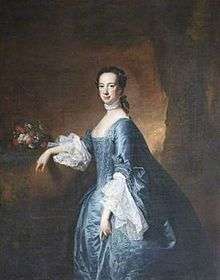Pill, Bishop's Tawton
Pill (alias Pille, Pylle, etc.) is an historic estate in the parish of Bishop's Tawton, near Barnstaple, in North Devon, England. The surviving 18th century mansion house known as Pill House is a grade II* listed building[1] situated close to the east bank of the River Taw about 1 mile south of the historic centre of Barnstaple and 1 mile north of Bishop's Tawton Church. It was long a seat of a junior branch of the Chichester family of Hall, Bishop's Tawton. At some time before 1951 it was converted into apartments[2] and is at present in multiple occupation.
Descent
de la Pille
The earliest recorded holder of the estate according to the Devon historian Sir William Pole (d.1635) was the de la Pille family, which took its name from the estate. Successive holders were:[3]
- John de la Pille
- Benedict de la Pille
- Michaell de la Pille (fl. 1315), who left his daughter as his sole heiress, who married Robert Fulk of Halmeston (mod: Halmpstone), Bishop's Tawton, to which family passed Pill.[4]
Fulk/Fowke
The descent of the Fulk family of Pill included:
- Robert Fulk of Halmeston (mod: Halmpstone) in the parish of Bishop's Tawton inherited Pill on his marriage to the de la Pille heiress of Pill. He was resident at Pill in 1345.[6]
- John Fulk, resident at Pill in 1376.[7]
- William Fulk, resident at Pill in 1393.[8]
Perrot
- Thomas Perrot, who acquired Pill on his marriage to a Fulk co-heiress of Pill.[10]
- John Perrot.[11]
- Thomas Perrot (fl. 1435)[12]
Travers
The Travers family from Hampshire succeeded Perrot at Pill.[13] Travers of Pill bore arms: Argent, three bears passant in pale sable muzzled and chained or,[14] which arms had been borne by Robert d'Estrivers, whose family was from Trévières, between Bayeux and Caen, in Normandy. According to the 1889 Battle Abbey Roll by the Duchess of Cleveland (1819-1901)[15]
- "During the reign of William the Conqueror (1066-1087) Robert de Travers or d'Estrivers, Baron of Burgh-upon-Sands, married the daughter of Ranulph de Meschines, Lord of Cumberland, and the sister of Ranulph Bricasard, who succeeded his cousin Richard d'Abrincis as Earl of Chester in 1119. He received from his father-in-law the office of Hereditary Forester of Inglewood in fee, which passed through his only child, Ibria, to Ralph de Engayne: and from the Engaynes to the Morvilles, who transmitted it to the Multons and Dacres. The badge of this office, the jagged branch, is over and over introduced in the chapel of Naworth Castle, which is so rich with arms and cognizances... This forestership of Inglewood was so honourable, and gave so great command, that there is no wonder the family should wish by every means to set forth their claim to it..."
Bryan Travers of Pill was the last in the male line and his daughter and heiress Catherine Travers (d.1613) brought the estate to her husband Hugh Chichester (1574-1644) of Tavistock.[16]
Chichester
The descent of Pill in the Chichester family was as follows:[17]
- Hugh Chichester (1574-1644) of Tavistock, who married Catherine Travers (d.1613), the daughter and heiress of Bryan Travers of Pill. He was the 8th son of John Chichester (d.1596) of Hall by his wife Elizabeth Marwood (d.1615), eldest daughter of John Marwood of Westcott, Devon.
- Arthur Chichester (1612-1687) (son and heir) of Stowford, about 5 miles south-east of Pill, in the parish of Swimbridge within the large manor of Bishop's Tawton. He married Anne Garland, daughter of John Garland of Whitefield.[18] He was predeceased by his eldest son Arthur Chichester (d.1682), whose mural monument survives in Swimbridge Church.

- Arthur Chichester (1670-1738), grandson, of Pill, eldest son of Arthur Chichester (d.1682) of Stowford. His younger brother Henry Chichester (1678-1730) resided at Stowford, and has a surviving mural monument in Swimbridge Church, whilst he himself resided at Pill.[20] He married firstly Jane Arundell (d.1717), daughter of John Harris Arundell of Wortham, by whom he had two sons, and secondly to Dorothy Rowe, by whom he had a further three sons and two daughters, one of whom was Anne Chichester (born 1721) the wife of Denys Rolle (1725-1797) of Stevenstone, near Great Torrington, the largest landowner in Devon, and mother of John Rolle, 1st Baron Rolle (1750-1842).[21] In 1698 he inherited the much larger estate of Hall on the death without progeny of his cousin Francis Chichester (1629-1698) of Hall.[22] Thenceforth Pill became a secondary residence of the Chichester family of Hall.
Sources
- Pole, Sir William (d.1635), Collections Towards a Description of the County of Devon, Sir John-William de la Pole (ed.), London, 1791, p. 414, Pille
- Risdon, Tristram (d.1640), Survey of Devon, 1811 edition, London, 1811, with 1810 Additions, p. 322
- Vivian, Lt.Col. J.L., (Ed.) The Visitations of the County of Devon: Comprising the Heralds' Visitations of 1531, 1564 & 1620, Exeter, 1895, pp. 176–8, pedigree of Chichester of Hall & Pill
References
- ↑ Listed building text
- ↑ 1951 listed building text
- ↑ Pole, p.414
- ↑ Risdon, p.322
- ↑ Pole, p.483
- ↑ Pole, p.414 regnal date 19 Edward III
- ↑ Pole, p.414
- ↑ Pole, p.414
- ↑ Pole, pp.483,496
- ↑ Risdon, p.322
- ↑ Pole, p.414
- ↑ Pole, p.414
- ↑ Risdon, p.322
- ↑ Pole, p.505
- ↑ Battle Abbey Roll by Catherine Stanhope (Duchess of Cleveland)
- ↑ Vivian, p.176
- ↑ Vivian, pp.176-8
- ↑ Vivian, p.177
- ↑ Collection of Great Torrington Almshouse, Town Lands and Poors Charities, Rolle/Clinton Art Collection
- ↑ Vivian, p.177
- ↑ Vivian, p.177
- ↑ Vivian, p.177